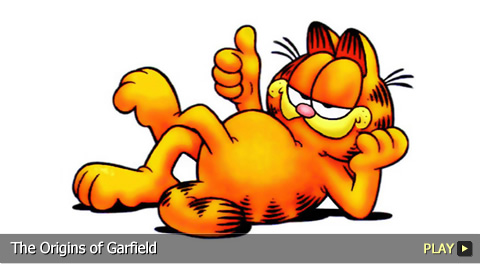The Origins of Garfield

He’d rather pig out than work out. Welcome to WatchMojo.com and today we’ll be taking a look at the origins of Garfield.
Garfield arrived on the scene on June 19th, 1978, and was the star of the self-titled comic strip by Jim Davis. This cartoon cat served up tons of laughs, one-liners and of course lasagna, and was the follow-up to Davis’ earlier comic strip “Gnorm Gnat.”
Garfield was crafted after Davis received feedback for that comic, and realized that no matter how well written and drawn, insects were not relatable.
Davis then created the title character as a composite of cats he knew growing up. He also paid tribute to his own grandfather, who was a large, argumentative man named James A. Garfield Davis.
The Garfield comic centered on the life of this cynical and extremely lazy orange cat. The character was given the non-verbal ability to communicate with his owner Jon Arbuckle, who was a character that originated in a 1950s coffee commercial.
Rounding out the primary cast was Odie. This lovable, long-eared beagle boasted a large slobbering tongue and below-average intelligence, and was a major source of laughs. He also paid tribute to a comedic persona from a car commercial that Davis had written years earlier called “Odie the Village Idiot.”
The series also spawned several side characters. These included Garfield’s veterinarian Dr. Liz Wilson, who became love Jon’s love interest, and Nermal, a female cat that Garfield continuously mailed to Abu Dhabi.
Garfield originally appeared in just 41 newspapers, but quickly became the fastest growing and most widely syndicated comic strip of all time. This popularity stemmed from the fact that audiences associated with the cartoon cat, especially his love of television and hatred of Mondays.
Garfield eventually appeared in over 2,500 newspapers, spawned his own website, and amassed a loyal audience of over 263 million readers from around the globe.
During this time, he also underwent an evolution where he slimmed down, learned to walk on his hind legs, and stopped squinting his eyes. These changes were meant to help him convey emotions, torment Odie, and reach for food.
Garfield became the most popular comic strip character of all time. He also starred in twelve primetime specials from 1982 onward, and his own animated TV show called “Garfield and Friends.” This program ran from 1988 to 1995, and spawned several other specials and series.
Garfield was not restricted to newspapers and television: he has also been featured on hundreds of other products, including clothing, toys and books. He also appeared in his very own live action film as a computer generated character voiced by actor Bill Murray, in 2004’s “Garfield: The Movie.”
Only two years later he returned to the silver screen in “Garfield: A Tail of Two Kitties.”
Fat, lazy and lovable, this cartoon icon lives the life most people wish they could get away with. Luckily for us, Garfield will continue to defend our right to eat junk food and take afternoon naps for years to come.
